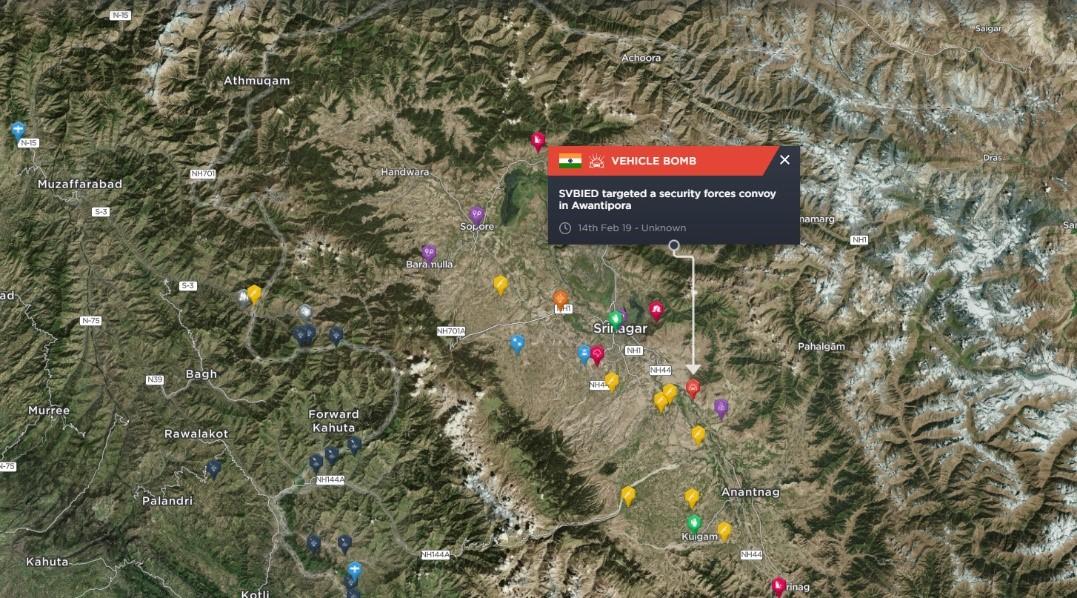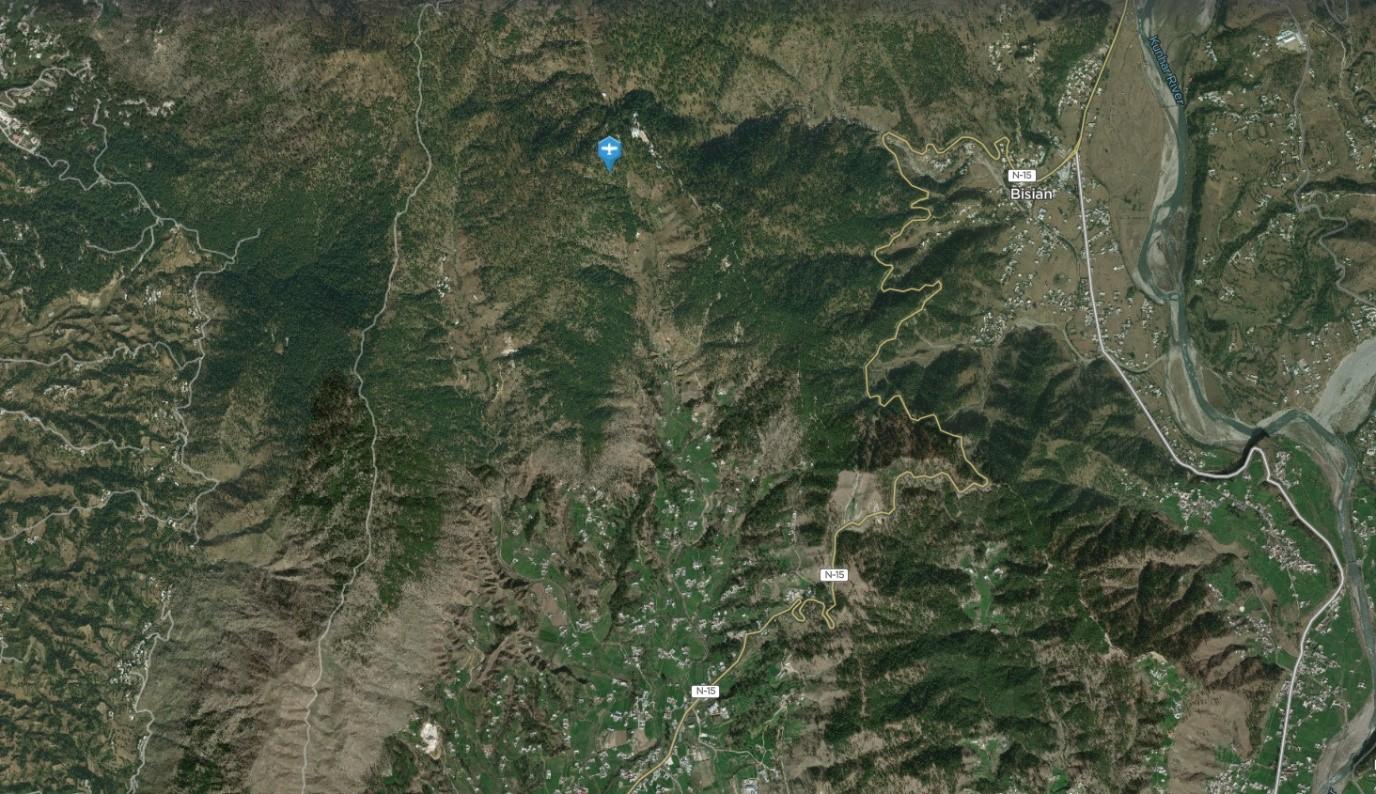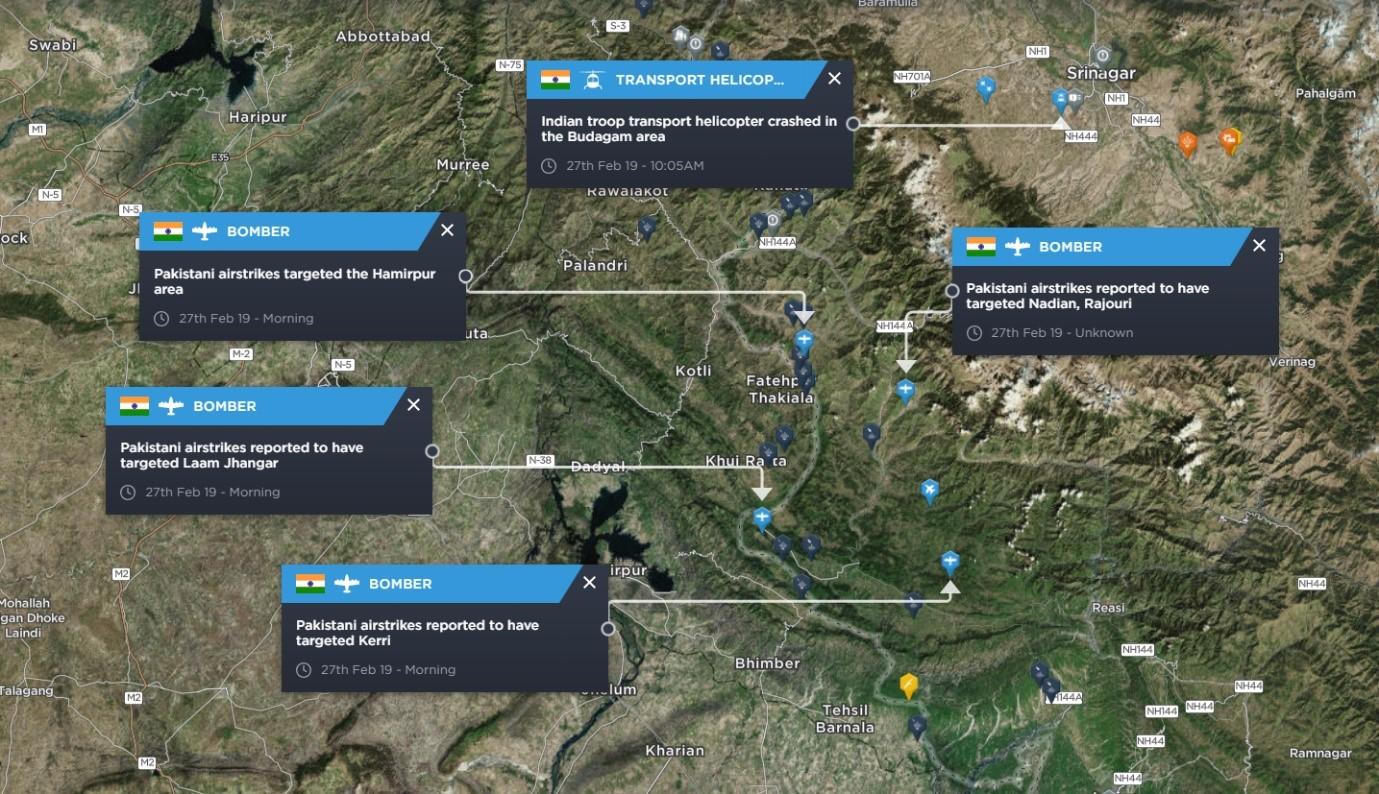Escalation Between India and Pakistan: The Key Events So Far
Tensions between India and Pakistan increased dramatically after a suicide vehicle bomb (SVBIED) was driven into a convoy of buses carrying personnel of the Indian Central Reserve Police Force (CRPF) in Pulwama. Terror attacks targeting Indian personnel in the area are common, but the casualty figures are rarely as high as the Pulwama attack, in which at least 40 CRPF personnel were killed and many more injured. The attack triggered a series of hostile actions between Pakistan and India along their border region, with tensions still high at the time this summary was written.
The events of the escalation have up until now been controlled, and open mechanised conflict along the border has been avoided. However, the potential for tensions to escalate is significant. The discourse emanating from both countries is frequently highly aggressive and suggests an appetite for conflict among sections of society. This attitude among voters serves to ensure that both Imran Khan and Modi must take a strong position towards each other and avoid coming across as weak at all costs. Prime Minister Modi of India also faces upcoming elections, adding an additional domestic political layer to decision making regarding tactical level operations. This summary will highlight and explain the key events which have taken place so far since the Awantipora SVBIED attack on February 14th.
Awantipora SVBIED Attack, February 14th
The Awantipora attack is the event where this particular escalation in tensions began, although tensions are continually high between the two nuclear armed neighbours. Artillery exchanges along the Line of Control (LoC) occur on a near daily basis, although civilian and military casualties are generally low.

The attack was carried out by a group called Jaish-e-Mohammed (JeM,) a group with bases in Pakistan and are highly active in Indian-administered Kashmir. The group has in the past fostered links with the Afghan Taliban and al-Qaeda, although al-Qaeda’s presence in the region has declined somewhat (but not disappeared) in recent years. The group’s activity mostly consists of firefights with Indian security forces and grenade attacks. The group is recognised as a terror outfit by a variety of countries, including the USA and Russia and is formally banned in Pakistan.
The Awantipora attack targeted a large convoy, believed to be carrying approximately 2,500 CRPF personnel in 78 vehicles, some of which were travelling in un-armoured civilian buses. The bomber, a 22 year old named as Adil Ahmad Dar, rammed a vehicle into one of the buses before detonating his explosives. The sheer volume of casualties raised the public awareness of the incident, and in turn applied pressure on Modi’s government to respond to the attack.
Indian Response – Balakot Airstrikes
Shortly after the attack, minor skirmishes were reported between JeM militants and Indian security forces in the Pulwama and Baramulla areas with low numbers of casualties. The full Indian response was to come in the form of an airstrike carried out in the Balakot area. The below images show the location of the strike, which caused much controversy within Indian and Pakistani media.

The strikes were very much a tale of two narratives. The Indian side claimed that they had targeted a major JeM training camp, killing and wounding approximately 300 militants. The Pakistani side at first denied the strike, and then ceded that a strike had taken place, but had missed its intended target. Narratives differed once again on what the target actually was. Reports from the ground suggest that the target was actually a madrassah under the influence of JeM, not a training camp. Shortly after the strike, reports began to emerge suggesting that one civilian had received light wounds, and houses in the nearby Jabba village had received some light damage.
The incident was a bold escalation, as the strike targeted a location far inside of Pakistani territory, therefore the risks of such an operation were incredibly high. Whilst the strikes themselves reportedly seem to have had almost no impact on JeM, they did serve to highlight the weakness of Pakistani defences in the area. With the attack not actually targeting Pakistani military personnel, it may be perceived as being less incendiary than a strike targeting a Pakistani military facility. Regardless, a strike in Pakistani territory with the two state’s historic relationship win mind was bound to lead to some form of escalation.
Increase in Cross Border Shelling Along the LoC
Shelling along the LoC in the Kashmir region is common and takes place on a near daily basis. However, since the Indian strikes in the Balakot area, the volume and intensity of the bombardments increased. Despite the significant increase in intensity, casualty figures remained relatively low, which helped restrain the conflict and subdue urges to escalate. At the time of writing this summary, cross-border artillery fire has continued at a daily rate, with both sides claiming that the opposing side initiated the isolated duals along the LoC.
Pakistani Strikes in Indian-Administered Kashmir
On the 27th February, Pakistan carried out airstrikes of their own in Indian-administered Kashmir. The exact targets are still not clear, but military headquarters and positions are reported to have been the primary targets. During these strikes, an Indian MI-17V-5 troop transport helicopter crashed due to a technical malfunction during the strikes, the helicopter is not believed to have been shot down.

By the time the Pakistani Air Force had carried out the strikes, tensions had risen to a point when both sides were on high alert, therefore the chance of being able to leave Indian airspace without contact was slim. As the PAF likely expected, Indian aircraft were scrambled to meet the attack. It is here where the majority of confusion surrounding the escalation has begun.
Initial reported claimed that two Indian aircraft were shot down as they scrambled to intercept the Pakistani fighters. First reports suggested that one of the pilots had been killed in the crash and the other was captured alive (Pakistani security forces retrieved the pilot from a crowd of angered locals.) However, as more reports were released, doubts were raised as to whether the dead pilot was in fact from a downed Pakistani aircraft. Whether or not a Pakistani aircraft was down is still a point of contention.
It is not immediately clear what aircraft were used in the dogfight on the Pakistani side. Pakistan denied that US-supplied F-16s were involved (which would violate an agreement between the USA and Pakistan.) In contradiction to this, India showed parts of an AMRAAM missile at a press release which they claim was fired during the dogfight. At the press release India claimed that the AMRAAM can only be fired from F16s. The Indian air force deployed Mig-21s during the incident to intercept the Pakistani aircraft, which are now a rather dated single seater fighter.
The downed Indian pilot, now a celebrity in India, was returned to India within 48 hours or so by Pakistani authorities without any obvious demands. The decision to release the pilot angered many Pakistani’s, who suggested that the act of goodwill was futile. The Indians rejected that the act was out of ‘good-will,’ and highlighted that prisoner return is an important part of the Geneva Convention. In reality, the release of the pilot was an impressive piece of statesmanship from Imran Khan. Not only did the move have the potential to de-escalate the crisis, it also placed Indian planners in a tough position. Both Pakistan and India were under pressure from powerful international observers such as China and the USA to step back from conflict and de-escalate. With this in mind, the release of the prisoner and its subsequent portrayal as an act of good will made any potential Indian response to the Pakistani strikes difficult. A strike immediately after the prisoner release would see Indian being viewed as aggressive and uncompromising.
Summary
It should be stressed that the escalation is by no means over, India has threatened to retaliate to the strikes and continues to highlight that JeM is able to operate within Pakistan. What course of action India will take going forwards is unclear. With international observers seemingly possessing very little appetite for conflict, the two sides will be hard pushed to justify a broader military confrontation, let alone decide on what they would intend to achieve from such a clash. With this said, potential for increased escalation, but limited to the Kashmir region, is certainly possible. Indian PM Modi is under substantial pressure to be seen to be responding to Pakistan’s most recent attack, and with elections looming, domestic pressure is amplified. Therefore, it is possible that additional limited strikes will take place in the near future. Without international backing, neither side’s policy makers appear to be embracing the prospect of open conflict.